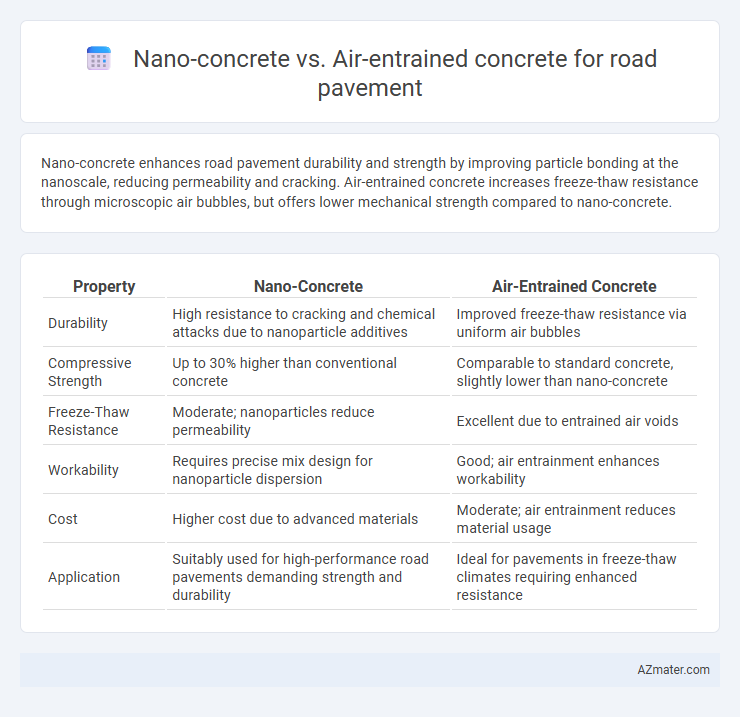Nano-concrete enhances road pavement durability and strength by improving particle bonding at the nanoscale, reducing permeability and cracking. Air-entrained concrete increases freeze-thaw resistance through microscopic air bubbles, but offers lower mechanical strength compared to nano-concrete.
Table of Comparison
| Property | Nano-Concrete | Air-Entrained Concrete |
|---|---|---|
| Durability | High resistance to cracking and chemical attacks due to nanoparticle additives | Improved freeze-thaw resistance via uniform air bubbles |
| Compressive Strength | Up to 30% higher than conventional concrete | Comparable to standard concrete, slightly lower than nano-concrete |
| Freeze-Thaw Resistance | Moderate; nanoparticles reduce permeability | Excellent due to entrained air voids |
| Workability | Requires precise mix design for nanoparticle dispersion | Good; air entrainment enhances workability |
| Cost | Higher cost due to advanced materials | Moderate; air entrainment reduces material usage |
| Application | Suitably used for high-performance road pavements demanding strength and durability | Ideal for pavements in freeze-thaw climates requiring enhanced resistance |
Introduction to Advanced Concrete Technologies
Nano-concrete utilizes nanoparticles to enhance cement hydration and microstructure, resulting in superior strength, durability, and reduced permeability compared to traditional concrete types. Air-entrained concrete incorporates microscopic air bubbles to improve freeze-thaw resistance and workability, making it widely used for road pavements in cold climates. Advanced concrete technologies like nano-concrete provide innovative solutions by increasing lifespan and performance under heavy traffic and environmental stress, while air-entrained mixtures offer proven durability in fluctuating temperature conditions.
Overview of Nano-Concrete
Nano-concrete incorporates nanoparticles such as nano-silica to enhance the microstructure, resulting in improved strength, durability, and resistance to cracking compared to traditional air-entrained concrete used in road pavements. The nano-scale additives promote denser cement hydration products, reducing porosity and increasing resistance to freeze-thaw cycles and chloride penetration, which are critical factors in pavement longevity. This advanced material offers superior mechanical properties and durability, making it a promising solution for extending the service life of road surfaces under heavy traffic and harsh environmental conditions.
Understanding Air-Entrained Concrete
Air-entrained concrete incorporates microscopic air bubbles that improve freeze-thaw resistance and durability in road pavements, enhancing lifespan under harsh weather conditions. This type of concrete reduces surface scaling and cracking by providing space for water to expand when it freezes, preventing internal damage. Compared to nano-concrete, air-entrained concrete emphasizes durability through controlled air voids rather than nanoscale particle enhancements.
Material Properties Comparison
Nano-concrete exhibits enhanced mechanical properties such as higher compressive strength, reduced porosity, and improved durability compared to air-entrained concrete, making it ideal for high-stress road pavement applications. Air-entrained concrete incorporates microscopic air bubbles to improve freeze-thaw resistance and workability but often sacrifices some compressive strength relative to nano-concrete. The integration of nano-silica or other nanomaterials in nano-concrete optimizes particle packing and microstructure, delivering superior resistance to wear, chemical attack, and cracking under traffic loads.
Durability Under Harsh Weather Conditions
Nano-concrete exhibits superior durability under harsh weather conditions compared to air-entrained concrete due to its enhanced nanostructure that reduces permeability and increases resistance to freeze-thaw cycles. The incorporation of nanoparticles in nano-concrete improves microstructural density, limiting water ingress and mitigating crack propagation caused by temperature fluctuations. In contrast, air-entrained concrete relies on microscopic air pockets to absorb freeze-thaw stress but is generally less effective against aggressive chemical attacks and prolonged moisture exposure in severe climates.
Strength and Load-Bearing Capabilities
Nano-concrete exhibits superior strength and load-bearing capabilities compared to air-entrained concrete due to the enhanced particle packing and reduced micro-cracks achieved by incorporating nano-sized additives such as nano-silica. This improvement results in higher compressive strength and increased durability under heavy traffic loads, making nano-concrete an ideal choice for road pavements subjected to intense mechanical stress. Air-entrained concrete, while beneficial for freeze-thaw resistance, generally offers lower mechanical strength and is less suited for high-load-bearing applications compared to nano-concrete.
Workability and Construction Efficiency
Nano-concrete exhibits superior workability due to the enhanced dispersion of nanoparticles, which improves the cement matrix's fluidity and reduces water demand, resulting in smoother mixing and easier placement compared to air-entrained concrete. Air-entrained concrete provides moderate workability with improved freeze-thaw resistance but often requires higher water content and admixtures, potentially slowing down construction processes. The enhanced workability of nano-concrete contributes to faster construction efficiency and reduced labor costs in road pavement applications, making it a more effective choice for durable and rapid road surface development.
Resistance to Freeze-Thaw Cycles
Nano-concrete exhibits superior resistance to freeze-thaw cycles compared to traditional air-entrained concrete due to its enhanced microstructure and reduced porosity, which limit water infiltration and damage. The incorporation of nanoparticles in nano-concrete effectively improves durability by refining the pore structure and increasing the material's density, resulting in fewer freeze-thaw induced cracks. Air-entrained concrete relies on entrapped air bubbles to relieve internal pressure during freezing, but nano-concrete offers a more robust and long-lasting solution for road pavement subjected to cyclic freezing and thawing conditions.
Cost Analysis and Economic Impact
Nano-concrete incorporates nanoparticles to enhance strength and durability, reducing maintenance costs and extending pavement lifespan compared to traditional air-entrained concrete. Although initial material costs for nano-concrete are higher, its superior resistance to cracking and freeze-thaw cycles decreases lifecycle expenses and frequency of repairs. Evaluating economic impact, nano-concrete offers long-term savings and improved road serviceability, making it a cost-effective solution for road pavement infrastructure.
Best Practices for Road Pavement Selection
Nano-concrete enhances road pavement durability and strength through improved particle packing and reduced porosity, making it ideal for high-traffic applications requiring long service life. Air-entrained concrete offers superior freeze-thaw resistance by entrapping microscopic air bubbles, which prevents cracking in cold climates. Selecting the appropriate concrete type depends on environmental conditions, traffic load, and maintenance requirements, with nano-concrete favored for structural performance and air-entrained concrete preferred for weather durability.

Infographic: Nano-concrete vs Air-entrained concrete for Road pavement
 azmater.com
azmater.com